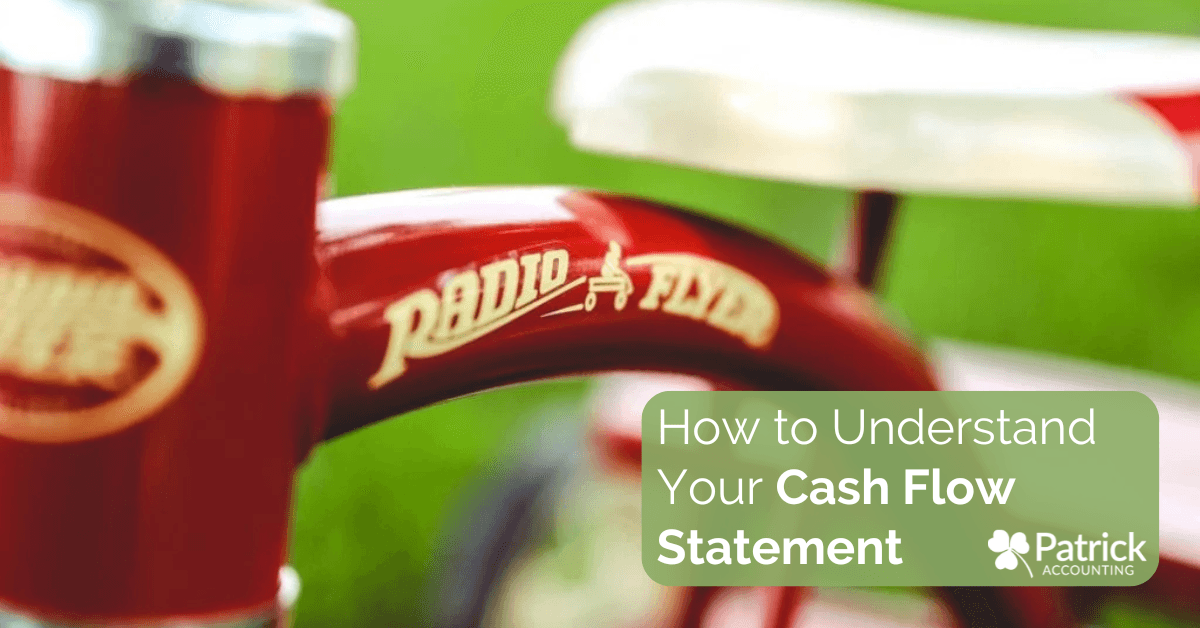Topics:
Search for topics or resources
Enter your search below and hit enter or click the search icon.

Have you ever looked at your bank account and thought, “Wait, where did all my money go?!?
If the balance sheet shows you where your money is, the cash flow statement shows you where it went.
Welcome to Part 4 of our series that we’ve created to help you, the small business owner, better wrap your head around your essential financial reports. So far we’ve covered:
So if you’re just joining us, I highly recommend that you go back and read those articles to catch up.
Don’t worry. We’ll be here when you get back.
(Humming “Eye of the Tiger"…)
If you’ve been following along with our bike-riding analogy (you did read the other articles, right?), then you’ll know it’s time to add the third wheel. So by the time you’re done with this one, as you’re learning to “ride” your financials, you’ll start to feel pretty stable—like you did as a kid riding a tricycle or one of those Big Wheels.
As the name suggests, the cash flow statement is a report showing how cash moves in and out of your business. It explains where your money has gone, helping you understand why your bank balance doesn’t always match the profit your income statement shows.
This section shows cash flow related to your day-to-day business operations. It covers purchases and expenses that might not yet show up on your income statement because they haven’t generated income yet. For instance, if you buy $5,000 worth of raw materials but haven’t sold the products made from them, this cost won’t appear on your income statement as an expense just yet.
However, it does impact your cash flow.
Operating activities also capture changes in some items over time, including:
For example, if your inventory increased from $1,000 to $6,000 due to a recent purchase, that extra $5,000 is reflected here as cash spent, even if it hasn’t yet hit your profit and loss statement.
This helps explain why you might show a profit, but there isn’t money in the bank from that profit yet.
This section records cash flow related to long-term assets or investments in your business. It captures major purchases, sales, or improvements of assets like:
Cash spent on these assets impacts your available cash but doesn’t show up on your profit and loss statement right away, as these are long-term investments. So, while it’s cash out the door, it’s not an immediate expense against income.
This is the area of your cash flow related to your liabilities (i.e. loans) and equity activity (owner’s draws or distributions.)
When you make a principal payment for a loan, you owe money on the principal. Payment isn’t reflected on your profit and loss report, but the cash still left your bank account. When you take money out for yourself as a draw this isn’t on your profit and loss, but it is out of your bank account.
Most commonly, you would include:
These financing activities explain some of the discrepancies between your profits and actual cash on hand. For example, paying down a loan reduces cash but doesn’t impact profit.
Using the indirect method of accounting (which most companies do) the “net earnings” shown on the income statement is the number used in the cash flow statement.
Depending on which period the cash flow statement is reporting, you would use two balance sheets to show the change between that period and the previous one.
For example, if you are generating a cash flow statement for November 2024, you would use the balance sheets from September 2024 and November 2024 to demonstrate that the net cash flow equals the increase or decrease in cash between those two periods.
Positive cash flow is a good indicator of financial health and can reassure creditors or investors that you’re able to cover expenses. It can give people looking into your business a good sense of whether or not they want to do business with you.
Generally, the more cash on hand, the healthier a company is.—hence the popular phrases “cash cow” and “cash is king.”
However, cash flow alone doesn’t tell the full story. A negative cash flow for a certain period isn’t necessarily a red flag; it could actually reflect explosive growth and lots of cash being spent to make that happen.
Timing. Timing. Timing. Just because you are showing a profit doesn’t mean the cash is in the bank.
Cash flow reflects actual money moving in and out of your account, while the income statement records revenue and expenses as they’re earned or incurred—sometimes before cash changes hands.
This difference is why cash flow changes can occur even when income and expenses haven’t yet hit your bank account. That’s why it takes all three reports—income statement, balance sheet, and cash flow statement—to get an accurate picture of your numbers.
There you have them: your three basic financial reports.
Hopefully, you’ve been able to get a better understanding of what these reports are and how valuable they can be to your small business.
What you can learn from these reports makes a huge difference, but at the end of the day, remember: you’re a business owner, not an accountant! When you’re just starting out, it’s probably easy to keep track of these things yourself. But as your business grows, things get more complex, and you’re wearing more 'hats' than ever.
The first hat you should think about taking off? The accounting hat. Outsourcing your accounting isn’t a luxury—it’s a lifeline. A great small-business accountant does way more than taxes; they’re here to help your business grow and thrive.
Ever thought about what could happen if you keep trying to go it alone? Check out The Cost of Not Having a Small Business Accountant to see why this might be the most valuable decision you make.
Topics: